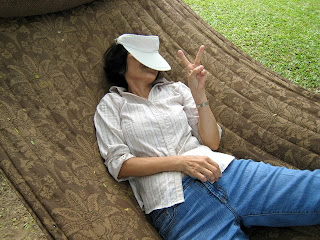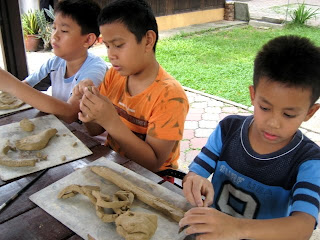
Photo credit : from brochure

'In my first thirty years of painting, it was as if I had spent thirty years in heaven. However, with this Foundation, I realized that to be involved in anything to do with the heart, you have to be strong and must not depend on others. With that in mind I have gone gone ahead up till this day.'- IB: A Life
We hopped from Rebak Island to the mainland to visit the Ibrahim Hussein Museum and Cultural Foundation. Finally we found it after asking at a pisang goreng stall for directions.
The white building perches on a hill looking desolate, in the Machincang Reserve. Luckily our worst fears were unfounded . A tinkle of the bell brought a caretaker to our service. Duly we paid a fee of RM12 each for tickets.
Without a shadow of doubt, as we stepped inside, it is a 'gem' indeed amidst the rainforest on Langkawi Island. Inside the gallery is spacious and white and occupies 2 floors. The private, non- profit foundation was launched in 1991 to develop art and culture of international status. It was Ib ( fondly called by his close friends) Hussein's selfless efforts - his belief that art is an important unifying force - that made this dream a reality.
Malaysia's iconic artist Datuk Ibrahim Hussein passed away in Feb 2009. I had recently bought a copy of Ib: A Life, the autobiography of Ibrahim Hussein. I found the book an interesting read. Luckily it is not a tome that I would have to go back and forth to. More than that, it is a peek into Ib the artist tracing his humble days in Kampung Sungai Limau Dalam, Kedah . As a child, he 'used to walk miles just to see a motorcar! It was a struggle for him as he journeyed to be artist , having to take on jobs as a postman, and even as a movie extra as the family was poor. Today Ib's paintings are widely collected by the who's who in Malaysia and abroad. Ib attributed his 'success' to fortuity. But it is evident from the book, his love and discipline for painting, and his honesty brought him many friends.
For myself, I've only seen and read about him in the media, a great smiling face. Like many Malaysians, we know of his fame as an artist related to the May 13th 1969 incident. When it was exhibited in 1969, it generated lots of interest and the locals referred to it a the 'black painting'. I was happy to see it up close (second time) in the museum.
'May 13th'
In response to the May 13th 1969 racial riots, Ib Hussein painted black over the Malaysian flag adding only a red line and a white circle below it.To Prime Minister,Tun Razak's questions: 'Ibrahim, is that a real flag?/ Why did you deface our national flag?' , Ib Hussein explained:
black - the darkness represents an eclipse the country was going through
red- the twilight that comes after the eclipse and darkness
white circle - symbolises a new energy and a rebirth
He added, ' To me, May 13th is not a national tragedy, it is a human tragedy; and could happen anywhere in the world if man chose to live like that.'
Eloquence won the day and he was allowed to exhibit the painting in the Dewan Tunku Canselor, Universiti Malaya. There was also a condition that ' May 13th' was not to be sold or be taken out of the country.





' My life is made of points, textures, colours, shapes, darkness and light, mass, weight, planes, volumes, sounds, smells, colours and warmth. ' - IB: A Life

Cambodia - Angkor Wat - image of Pol Pot emerging from the cracks of the ruins

Ib Hussein: ' Many incidents that were happening around me made me realise I had to fulfil a serious commitment in art. I began to see that it is the duty of the artist to paint for his fellowmen the suffering and ecstasy of his time.' - IB : A Life

India's 'Bandit Queen' Phoolan Devi ( 1968-2001) - representing the subjugation of women and the downtrodden


Sharing light moments with caretaker of the museum after an enlightening visit.










































